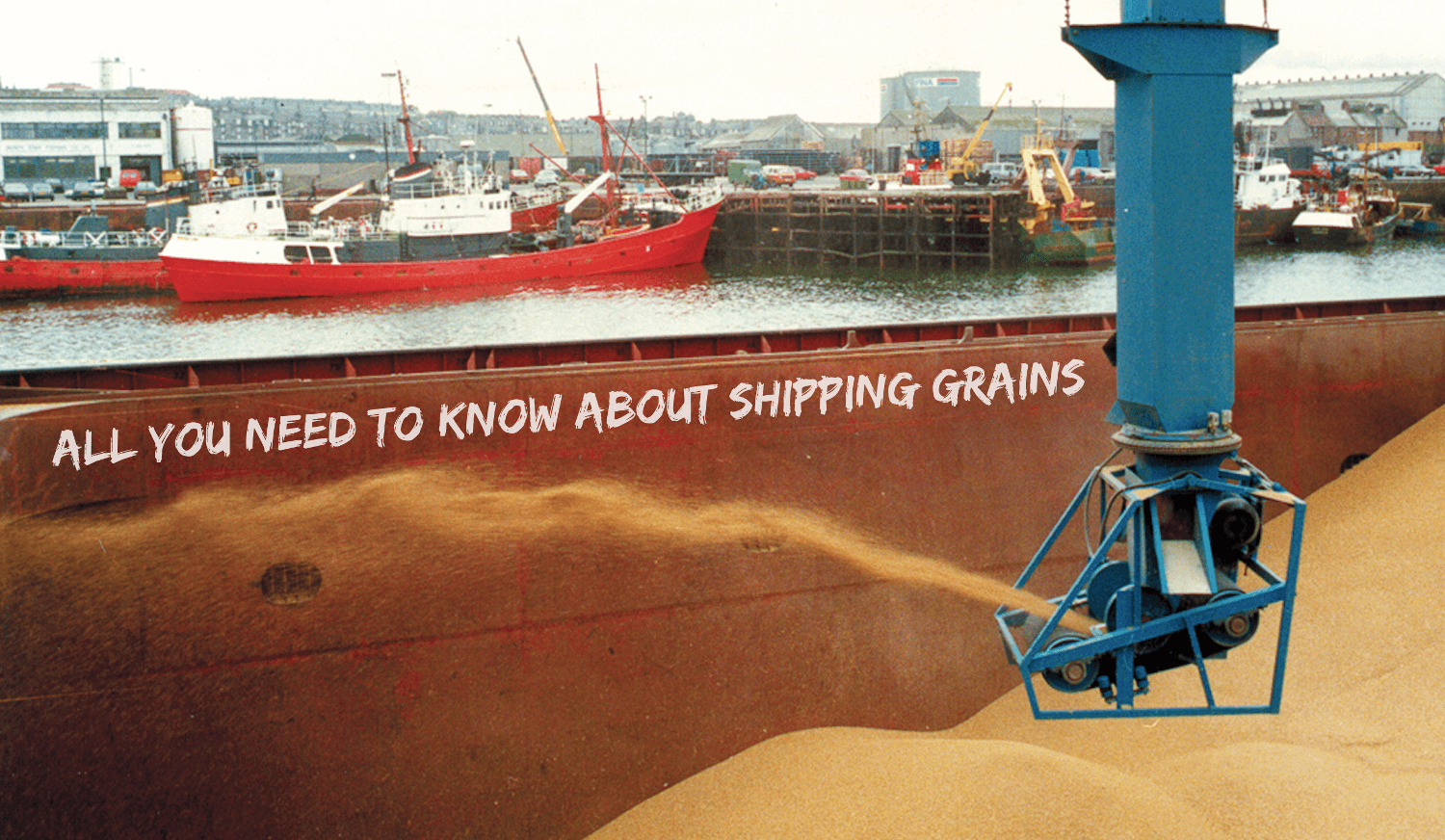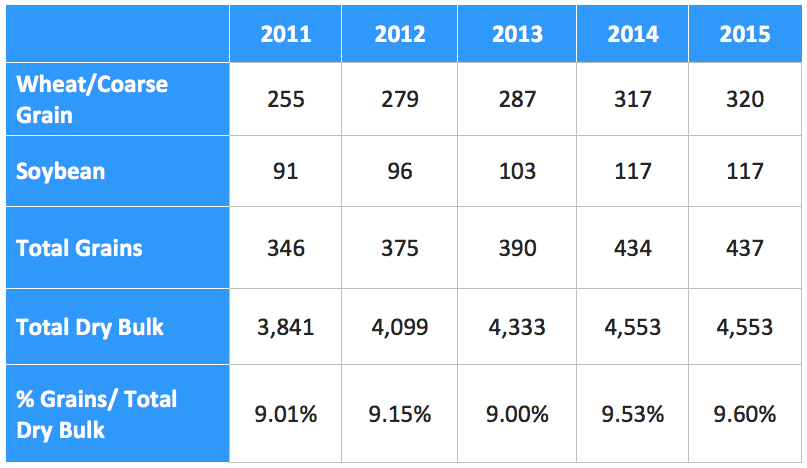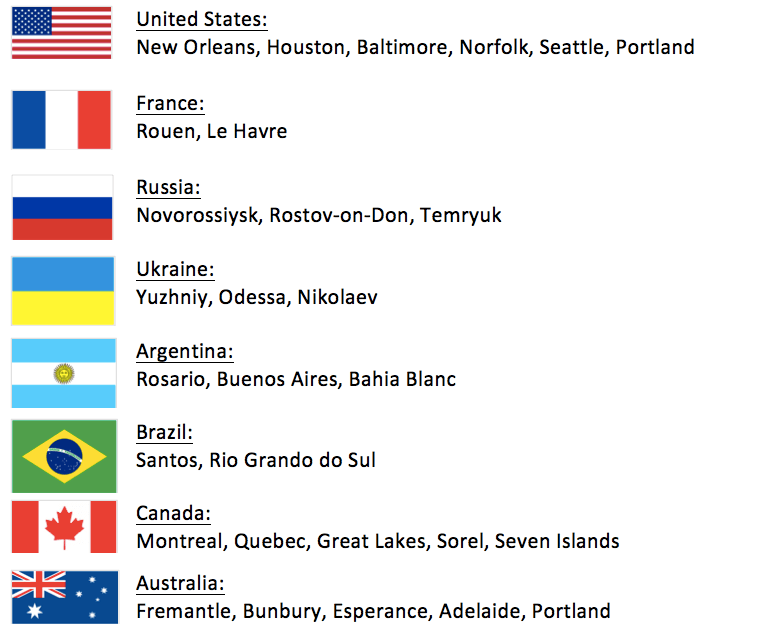
Read More: https://www.opensea.pro/blog/shipping-grains
Millions of dry bulk commodities are traded every day and loaded into bulk carriers. Chartering people circulate hundreds of inquiries with coal, iron ore, grains, fertilizers, steel products, general cargo, scrap, sugar, logs, pellets and various other minor commodities. The three major dry bulk cargoes are the iron ore, coal and grains. Specifically grain is the third major cargo in terms of seaborne trade and it is accounted for about 9.50% of the total dry bulk trade worldwide with about 430 million tons to be traded per year (as per 2014 & 2015 data) of which the about 320 million tons (about 74%) refer to wheat and coarse grain, while about 110 million tons (about 26%) is the soybean. Coarse grain refers to cereal grains other than wheat and rice which are mainly used for animal feed and brewing. The below table presents the world trade of grains (in million tons) during the 5 last years as well as the grains trade as a percentage of the total dry bulk trade.

Main Exporters & Importers of Grain products
The largest grain exporter is USA, holding a share of about 25% (as per data of 2014/15 crop year) followed by Europe, Argentina, Ukraine, Russia, Brazil, Canada and Australia. USA is a very strong exporter of coarse grain, holding the leading position in this category with about 35% of the total worldwide exports, while Europe is the leader exporter of wheat, holding about the 22% of the total exports. On the other hand, Argentina and Brazil are the major exporters of soybean, with both of them having a share of more than 65% of the world exports of soybean. Main ports exporting grains are the following:
Read More: https://www.opensea.pro/blog/shipping-grains

At this point, it is worth to note that a major grain producer is China (about 18% of the world production) however its production is utilized in local consumption and it is not exported. There is such high need for grain products in China that not only they consume their own production but they are also the largest importer of grain products in the world!
The largest importers of grain products are China, Japan, Egypt, Europe, Saudi Arabia, South Korea and Iran. China imports about the 8% of the world, however its importing activity is volatile and usually depends on the levels of its own production. China, Japan and South Korea usually import grains from Australia, West Coast Canada, USA, Argentina and Brazil. Due to the high quantities involved and the long distances, these trades are usually performed with Supramax or Panamax vessels. In some cases Capesize bulkers are also utilized while some Handies may be seen in the trade flows from Australia or West Coast Canada. Egypt and the other North African countries (e.g. Morocco and Algeria) are importing grains mainly from Ukraine and Russia as well as from European countries and mainly from France. This trade is usually performed with smaller vessels like Handies or Supramaxes, and even Coasters. Similar is the case in the imports to Europe which usually takes place from Ukraine, Russia –unless any bans are in place– other European countries and in less extend from USG or East Coast Canada. Handies and Supramaxes are mainly utilized for this trade. On the other hand, Iran, Saudi Arabia and the other Arabian Gulf countries are mainly importing grains from South America (Argentina or Brazil) as well as Australia. Panamax bulkers are usually utilized in this trade while in some case we also meet Supramaxes or Capes depending on the cargo quantity of each shipment.
Usually, the ports in USA, Canada, Australia and Europe do have stricter standards for the approved vessels which are mainly related with a maximum age or Rightship status of higher than 3 stars. Vessels which do not follow these limitations usually cannot be fixed in such trades making the potential candidates less, a factor which increases the freight rates in those specific trades. Like what you’re reading? Get the latest updates first. Get Exclusive Updates
The Seasonal Effect on Freight Rates
The grain trade is seasonal with the shipments to increase mainly during the harvest period. Harvest period in USA, European countries, Canada, Russia and Ukraine is taking place during August-September each year. While USA, Canada and Europe are also known for their winter wheat with the harvest period taking place from May to July. The Australian wheat is mainly grown in the winter season according to the rainfall patterns in these regions and the harvest period is usually during October-January each year. On the other hand, harvest period for wheat in South America (Argentina) is taking place during December – January, harvester period of corn is during January – April and harvester period of soybean, which is the main exporting product in South America, is taking place during March – June. Therefore, there is high exporting activity during the whole period from December to June each year.
During the harvest period, demand for shipping services is increased which considerably boosts the freight market. This is more apparent in the harvest of the South America and this is because Argentina and Brazil feed with grain cargoes the Asian countries and this trade increases the ton-mile demand since the vessels need more than 3 months to perform a round voyage. There are also shipowners who strategically prefer to reposition their vessels in South America slightly before the opening of the harvest season so as to be candidates and get a good premium upon the opening of the harvest season. Also due to the fact that most of the main exporting countries are located in Atlantic, historically the Atlantic market is better-paying than the Pacific market.
Specifics of Loading & Discharge Grains
Grain cargoes also require special handling at the loading and discharge ports. In the major grain loading ports of the world, the grain is transported to the terminals by rail, road or barge. The developed nations have a complete internal network of elevators which are collecting points for local harvesting centers. These are linked with the seaboard via rail sidings, specialized grain railcars, road transport or special barges where river transport is involved (e.g. New Orleans). Grain cargoes are stored in special facilities and where storage facilities are not sufficient, temporary facilities like factories etc are used to secure the surplus quantity. It is unusual nowadays more than one grades of grain products to be loaded in a vessel but where this is the case, then separators should be used and great care to be taken so as to avoid mixture of the different grades. Also in case more than one grades are going to be loaded, a specific clause should be incorporated in the charter party which will regulate the risks/costs/responsibilities of the parties.
Discharge operations may vary between the countries. The most usual method is the one of discharging by crane and clamshell grabs into hoppers on the decks, feeding direct to the road transport or from hoppers to sacking machines with the bags being stack in near warehouses. In other locations like Europe and Japan the discharge may be performed by suction unloaders while conveyor belts are used to transship the grain to store in associate silos. In smaller ports, on the other hand, the clamshell grabs are fitted to ship’s gear and it is discharged by ship’s cranes the same way as in case of shore crane’s described above.
In case of countries with poor inland facilities (e.g. West African countries), grains are loaded and moved only in bagged form while in other cases they are loaded in bulk and bagged later at the destination port.
Furthermore, grain cargo is very sensitive to weather conditions and loading or discharge operations will cease upon raining. Due to this fact, it is very important during charter negotiations to take additional care of the laytime terms of the Charter party since the additional waiting time, if not paid with demurrage, will easily spoil the final output of the voyage.
Most Common Grain Charter Parties
There are grain voyages that use the generic Gencon c/p, the contents of which we analyzed in a previous article, however most of the grain voyages use their own charter parties which are even more specific. The main C/Ps which are used in this trade are the following:
#GRAINCON – This is the generic grain charter party which is produced by BIMCO and can be used in any grain trade worldwide.
#SYNACOMEX – This form is drafted by “Syndicat National du Commerce Extérieur des Céréales” and it is mainly used in trades coming out of the European Continent and especially from France.
#NORGRAIN – This form is prepared by the Association of Ship Brokers and Agents (USA) Inc. and it is mainly used in trades coming out USA and Canada. #BFC (Baltimore Form C) – This is a second form which is mainly used in trades coming out of USA & Canada.
#AUSTWHEAT – This form is drafted by the Australian Wheat Board and the Chamber of Shipping of the UK and it is mainly used in trades coming out of Australia.
#AUSGRAIN – This is second form which is mainly used in grain trades coming out of Australia.
#NORGRAINS – This form is issued by the Association of Ship Brokers and Agents (USA) Inc and it is mainly used in trades coming out of South America.
#CENTROCON – This form is approved by the Chamber of Shipping of the United Kingdom and it is used in grain trades coming out of South America and specifically River Plate.
The GRAINCON which is produced by Bimco is considered more favorable to Owners however the other charter parties have been drafted and produced by local organisations of exporting countries which are considered to be closer to the shippers and therefore it is supposed that they include more Charterer’s favorable terms. During negotiations of main terms, it is essential to be mentioned and agreed which charter party form will regulate the parties’ relationship and this is a usual point of dispute between the parties especially in case they fix for the first time. Special clauses which can meet only in grain charter parties are mainly related with: stricter conditions related with vessel’s condition and hold cleanliness due to the sensitivity of the cargo, separation of different grades of grains, fumigation or the removal of beam.
OpenSea Team understand the importance of the grain sector in the shipping industry and our online marketplace accommodates grain cargoes at any position all over the world as well as vessels ready to load such cargoes. Furthermore, Opensea helps Charterers & Shipowners observe the balances and imbalances of the supply and demand conditions in every region with all participants gaining additional advantage during the periods of rising or falling market. At the same time, ships and cargoes stay private so both parties can place their open positions and find relevant business way faster.
Read More: https://www.opensea.pro/blog/shipping-grains

